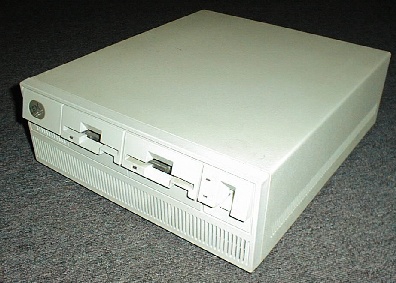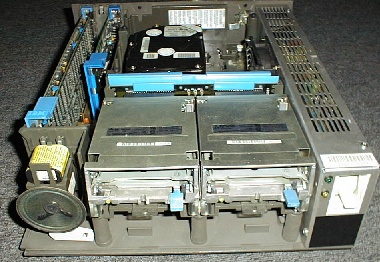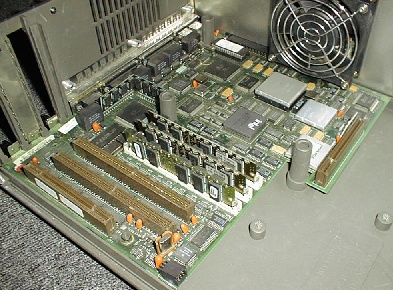
Click here or click onto the photo for a full size version of this picture.
The Model 70 was IBM's first desktop 386 machine (the model 80 in a tower case came a few months earlier with the first series of PS/2s). Mechanically, it is very similar to the Model 50: the case is almost the same. The subtle differences in its construction are hidden inside:

Click here or click onto the photo for
a full size version of this picture.
Since it was even clear to IBM that a 386-class machine with a 20MB/85ns MFM drive (the drive originally used in the model 50) wouldn't sell, the Model 70 was designed as an ESDI-based machine from the beginning. IBM therefore removed the 4th slot that allowed a choice between MFM and ESDI in the Model 50 and moved the ESDI/DBA electronics (which is not very much, since DBA is the MCA-equivalent of IDE) onto the mainboard. The mechanical link between mainboard and drive was now done via the floppy connector PCB; as a result, the drive had to be rotated by 90 degrees. IBM also moved the fan from the machine's back to the power supply. The nice result is that the space for the drive itself increased; the plastic frame has rails to hold a 5,25-inch drive, I have however never seen a Model 70 that actually had such a drive.
It seems that IBM did not want to make a new base plastic frame for the 70, since it still has slots in its back that were originally needed for the 50's fan; the upper plastic frame simply covers the slots and the air flows in the desired way.

Click here or click onto the photo for
a full size version of this picture.
The integration of the 16/20 MHz model is similar to the 50Z: the planar board only occupies about half of the space the case offers. Once again, some vertically-mounted daughter PCBs help reducing the size of the main board. In detail, the following circuits were moved to daughter cards:
- Video memory (2x 128Kbytes)
- Floppy clock generator/PLL
A later generation of the Model 70, the 70-Axx series, had a larger planar and a separate CPU module and formed the base for IBM's first 486 machine.
There are also variants of the 20 MHz board with full size. Below is a photo of such a planar:

Click here or click onto the photo for
a full size version of this picture.
- Processor:
- IBM 386DX @ 20MHz
- Coprocessor:
- Intel i387DX @ 20 MHz
- Cache:
- none
- Memory:
- 6 Mbytes (options range from 2M to 6M)
- Bus:
- 3 MCA slots (16/32 bit)
- Interfaces (onboard):
-
- Mouse, Keyboard
- 1x Serial
- 1 x Parallel
- Floppy (1.44M), allows attachment of up to 2 drives
- VGA
- ESDI hard disk (DBA interface)
- Add-on cards:
-
- 3COM 3C529 Ethernet Adapter
- IBM 8514/A Video Adapter
- Operating System(s):
-
- Linux 2.0 (Slackware-based)
- Caldera OpenDOS 7.01
- Useful Links: